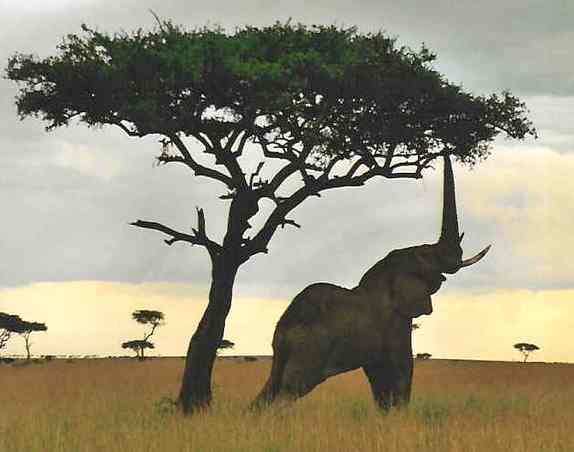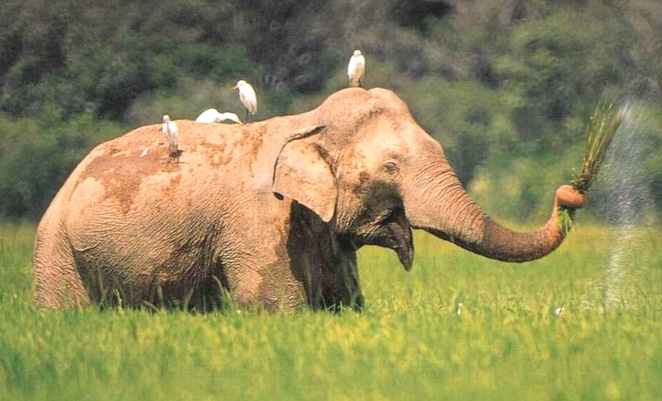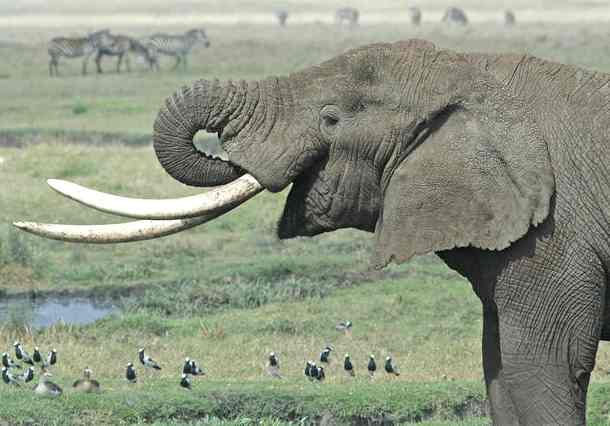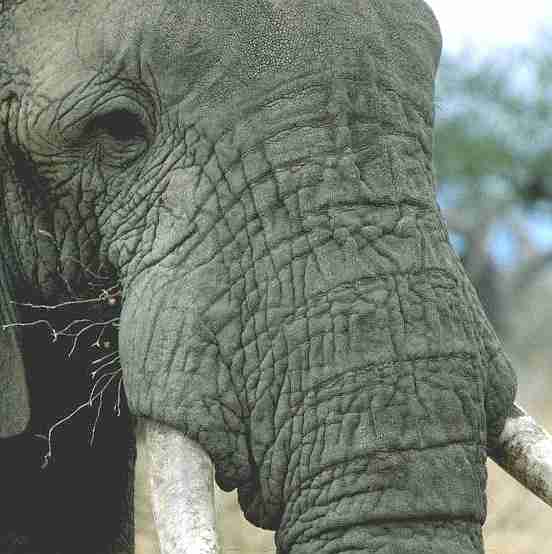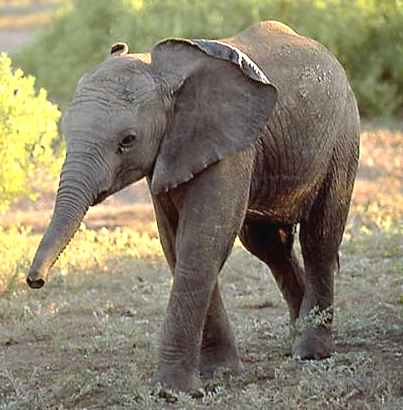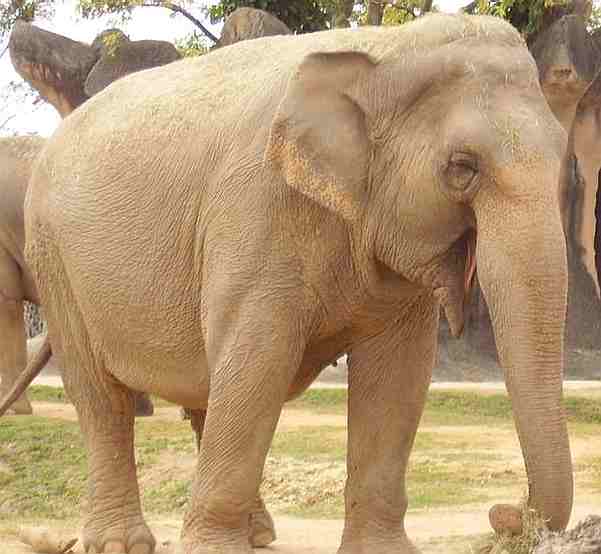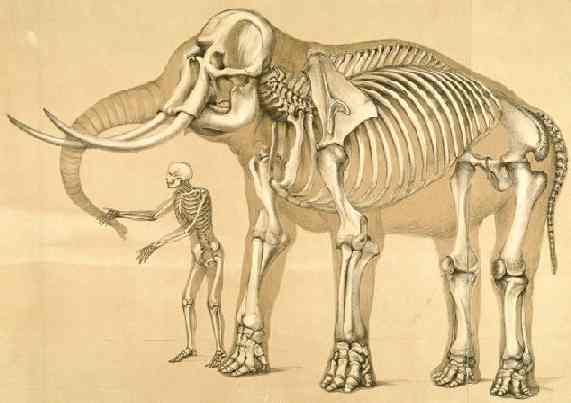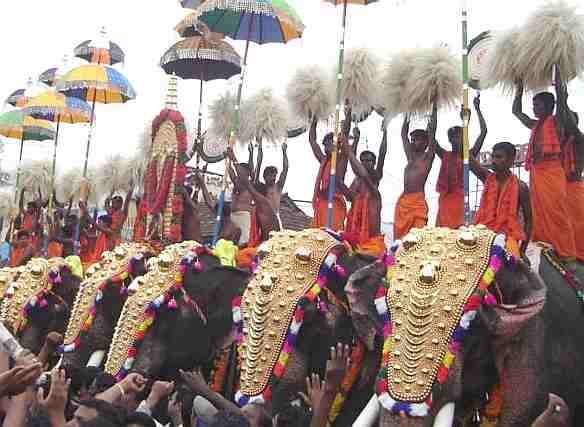|
ELEPHANTS
|
|||||||||||||||||||||||||||||||||||||||||||||||||
|
Elephantidae (the elephants) is a family of pachyderm, and the only remaining family in the order Proboscidea in the class Mammalia. Elephantidae has three living species: the African Bush Elephant and the African Forest Elephant (which were collectively known as the African Elephant) and the Asian Elephant (also known as the Indian Elephant). Other species have become extinct since the last ice age, which ended about 10,000 years ago.
African Bush (Savannah) Elephant in Kenya.
Elephants are mammals, and the largest land animals alive today. The elephant's gestation period is 22 months, the longest of any land animal. At birth it is common for an elephant calf to weigh 120 kg (265 lb). An elephant may live as long as 70 years, sometimes longer. The largest elephant ever recorded was shot in Angola in 1974. It was male and weighed 12,000 kg (26,400 lb). The smallest elephants, about the size of a calf or a large pig, were a prehistoric variant that lived on the island of Crete until 5000 BC, possibly 3000 BC. Their scattered skulls, featuring a single large trunk-hole at the front, perhaps formed the basis of belief in existence of cyclops, one-eyed giants featured in Homer's Odyssey.
Elephants are increasingly threatened by human intrusion, with the African elephant population plummeting from 3 million in 1970 to roughly 300,000 today, and human-elephant conflict killing 150 elephants and up to 100 people per year in Asia. The elephant is now a protected species worldwide, placing restrictions on capture, domestic use, and trade in products such as ivory.
African Elephant
The mammals of the genus Loxodonta, often known collectively as African elephants, are found in several regions throughout the continent, after which they are named. In recent years, Loxodonta has received the attention of the world because of its dwindling numbers. Today there are approximately 600,000 African elephants in the world. Some believe this represents a stable population and that measures to protect them are unnecessary. Others argue that while elephants are locally overabundant in certain areas, it is impossible to ignore the fact that the overall population has dropped by a staggering amount. As recently as 1979 there were an estimated 1.3 million African elephants. Now only around 600,000 remain. This decline is attributed primarily to poaching, or illegal hunting, and habitat loss.
African elephants are distinguished from Asians in several ways. The most noticeable difference is the ears. Africans' ears are much larger and are shaped like the continent of their origin. The African elephant is typically larger than the Asian and has a concave back. Both males and females have external tusks and are usually less hairy than their Asian cousins.
Until the late 20th century, scientists recognized one species of African elephants, Loxodonta africana, and two subspecies, or races, within the species. Recent DNA analysis has led scientists to reclassify the two races as distinct species.
Today, Loxodonta africana refers specifically to the Savanna Elephant, the largest of all the elephants. In fact, it is the largest land animal in the world, standing up to 13 ft (4 m) at the shoulder and weighing approximately 15,400 lb (7,000 kg). The average male stands about 3 m (10 ft) high at the shoulder and weighs about 5500–6000 kg, female being much smaller. Most often, Savanna Elephants are found in open grasslands, marshes, and lake shores. They range over most of Africa, south of the Sahara Desert.
The other, less numerous species is the Forest Elephant, recently reclassified as Loxodonta cyclotis. Compared with the Savanna Elephant, its ears are usually smaller and rounder, and its tusks are also thinner and straighter and are not directed outwards so much. The Forest Elephant can weigh up to 10,000 lb (4,500 kg) and stand about 10 ft (3 m) tall. Much less is known about these animals than their savanna cousins because environmental and political obstacles make them very difficult to study. Normally they inhabit the dense African rain forests of central and western Africa, though occasionally they do inhabit the edges of forests and overlap territories with bush elephants.
Indian Elephant - Sri Lanka
Asian Elephant
Today scientists estimate the world population of Asian elephants, also called Indian Elephants or Elephas maximus, to be approximately 40,000, less than one-tenth the number of African elephants. Perhaps the Asian elephants' decline has been less noticeable because it has been more gradual. The causes of this decline are much the same as that of the African.
As with the Loxodonta, there are distinct subspecies of Elephas maximus. In general, the Asian elephant is smaller than the African. It has smaller ears, shaped like the subcontinent of India, and typically only the males have large external tusks. An Asian elephant can also be distinguished by the large bulges of depigmentation on the skin.
The first subspecies is the Sri Lankan Asian Elephant (Elephas maximus maximus). Found only on the island of Sri Lanka, a small country off the southeast coast of India, it is the largest of the Asians. There are an estimated total of only 3,000-4,500 members of this subspecies left today in the wild, although no accurate census has been carried out in the recent past. Large males can weigh upward to 12,000 lb and stand over 11 feet tall. Sri Lankan males have very large cranial bulges, and both sexes have more areas of depigmentation than are found in the other Asians. Typically their ears, face, trunk, and belly have large concentrations of pink-speckled skin. There is an Orphanage for elephants in Pinnawala Sri Lanka, which gives shelter to disabled, injured elephants. This program plays a large role in protecting the Sri Lankan Elephant from extinction.
Another subspecies, the Mainland Asian Elephant (Elephas maximus indicus) makes up the bulk of the Asian elephant population. Numbering approximately 36,000, these elephants are lighter gray in colour, with depigmentation only on the ears and trunk. Large males will ordinarily weigh only about 11,000 lb but are as tall as the Sri Lankan. The mainland Asian can be found in 11 Asian countries, from India to Indonesia. They prefer forested areas and transitional zones, between forests and grasslands, where greater food variety is available.
The smallest of all the elephants is the Sumatran Asian Elephant (Elephas maximus sumatranus). Population estimates for this group range from 33,000 to 53,000 individuals. It is very light gray and has less depigmentation than the other Asians, with pink spots only on the ears. Mature Sumatrans will usually only measure about 10 ft (3 m) at the shoulder and weigh less than 9,000 lb. An enormous animal nonetheless, it is considerably smaller than its other Asian (and African) cousins and exists only on the island of Sumatra, usually in forested regions and partially wooded habitats.
In 2003 a further subspecies was identified on Borneo. Named the Borneo pygmy elephant, it is smaller and more tame than other Asian elephants. It also has relatively larger ears, longer tail and straighter tusks.
Body characteristics
Elephant calves
Elephant social life, in many ways, revolves around breeding and raising of the calves. A female will usually be ready to breed around the age of thirteen, at which time she will seek out the most fit male to mate with. (The word fitness, in an evolutionary sense, means the animal best suited to survive in its environment and pass on its genes.) Females want to breed with the bigger, stronger, and, most importantly, older males. In this way, they are assuring that their offspring will have the best possible chance of survival.
After a twenty-two-month pregnancy, the mother will give birth to a calf that will weigh about 250 lb and stand over 2½ feet tall. Elephants have a very long childhood. They are born with fewer survival instincts than many other animals. Instead, they must rely on their elders to teach them the things they need to know. The ability to pass on information and knowledge to their young has always been a major asset in the elephant's struggle to survive. Today, however, the pressures humans have put on the wild elephant populations, from poaching to habitat destruction, mean that the elderly often die at a younger age, leaving fewer teachers for the young.
All members of the tightly knit female group participate in the care and protection of the young. Since everyone in the herd is related, there is never a shortage of baby-sitters. In fact, a new calf is usually the center of attention for all herd members. All the adults and most of the other young will gather around the newborn, touching and caressing it with their trunks. The baby is born nearly blind and at first relies, almost completely, on its trunk to discover the world around it.
An elephant in the Ngorongoro crater, Tanzania
Allomothers
After the initial excitement dies down, the mother will usually select several full-time baby-sitters, or "allomothers", from her group. According to Cynthia Moss, a well-known researcher, these allomothers will help in all aspects of raising the calf. They walk with the young as the herd travels, helping the calves along if they fall or get stuck in the mud. The more allomothers a baby has, the more free time its mother has to feed herself. Providing a calf with nutritious milk means the mother has to eat more nutritious food herself. So, the more allomothers, the better the calf's chances of survival.
Trunk
The proboscis, or trunk, is a fusion of the nose and upper lip, elongated and specialized to become the elephant's most important and versatile appendage. African elephants are equipped with two fingerlike projections at the tip of their trunk, while Asians have only one. According to biologists, the elephant's trunk is said to have over forty thousand individual muscles in it, making it sensitive enough to pick up a single blade of grass, yet strong enough to rip the branches off a tree.
Most herbivores (plant eaters, like the elephant) are adapted with teeth for cutting and tearing off plant materials. However, except for the very young or infirm, elephants always use their trunks to tear up their food and then place it in their mouth. They will graze on grass or reach up into trees to grasp leaves, fruit, or entire branches. If the desired food item is too high up, the elephant will wrap its trunk around the tree or branch and shake its food loose or sometimes simply knock the tree down altogether. The trunk is also used for drinking. Elephants suck water up into the trunk (up to fifteen quarts [14.2 liters] at a time) and then blow it into their mouth. Elephants also inhale water to spray on their body during bathing. On top of this watery coating, the animal will then spray dirt and mud, which act as a protective sunscreen.
This appendage also plays a key role in many social interactions. Familiar elephants will greet each other by entwining their trunks, much like a handshake. They also use them while play-wrestling, caressing during courtship, and for dominance displays - a raised trunk can be a warning or threat, while a lowered trunk can be a sign of submission. Elephants can defend themselves very well by flailing their trunk at unwanted intruders or by grasping and flinging them.
An elephant also relies on its trunk for its highly developed sense of smell. Raising the trunk up in the air and swivelling it from side to side, like a periscope, it can determine the location of friends, enemies, and food sources.
Tusks
The tusks of an elephant are upper incisors that grow continuously. An adult male's tusks will grow about seven inches a year. Tusks are indispensable to an elephant. They are used primarily to dig for water, salt, and roots; to debark trees, in order to get at the tasty pulp inside; and to move downed trees and branches when clearing a path. In addition, they are used for marking trees to establish territory and occasionally as weapons.
Like humans who are typically right- or left-handed, elephants are usually right- or left-tusked. The dominant tusk, called the master tusk, is generally shorter and more rounded at the tip from wear. Both male and female African elephants have large, impressive tusks that can reach over 10 ft (3 m) in length and weigh over 200 lb (90 kg). In the Asian species, only the males have large tusks. Female Asians have tusks which are very small or absent altogether. Asian males can have tusks as long as the much larger Africans, but they are usually much slimmer and lighter; the heaviest recorded is only 86 lb (39 kg). The tusk of both species is mostly made of calcium and phosphate. As a piece of living tissue, it is relatively soft (compared with other minerals such as rock), and the tusk, also known as ivory, is strongly favoured by artisans for its carvability. The desire for elephant ivory has been one of the major factors in the dramatic decline of the world's elephant population.
Teeth
Elephants' teeth are very different from those of most other mammals. Over their lives they usually have 28 teeth. These are:
Unlike most mammals, which grow baby teeth and then replace them with a permanent set of adult teeth, elephants have cycles of tooth rotation throughout their entire life. After one year the tusks are permanent, but the other teeth are replaced five times in an elephant's life. The teeth do not emerge from the jaws vertically like with human teeth. Instead, they have a horizontal progression, like a conveyor belt. New teeth grow in at the back of the mouth, pushing older teeth toward the front, where they wear down with use and the remains fall out. When an elephant becomes very old, the last set of teeth is worn to stumps, and it must rely on softer foods to chew. Very elderly elephants often spend their last years exclusively in marshy areas where they can feed on soft wet grasses. Eventually, when the last teeth fall out, the elephant will be unable to eat and will die of starvation. However, as more habitat is destroyed, the elephants' living space becomes smaller and smaller; the elderly no longer have the opportunity to roam in search of more appropriate food and will, consequently, die of starvation at an earlier age.
Tusks in the lower jaw are also second incisors. These grew out large in Dinotherium and some mastodons, but in modern elephants they disappear early without erupting.
Skin texture of an African elephant
Skin
Another name for an elephant is pachyderm, which means "thick skin". An elephant's skin is extremely tough around most parts of its body and measures about 2.5 cm (1 in) thick. However, the skin around the mouth and inside of the ear is paper thin. Normally, the skin of an Asian is covered with more hair than its African counterpart. This is most noticeable in the young. Asian calves are usually covered with a thick coat of brownish red fuzz. As they get older, this hair darkens and becomes more sparse, but it will always remain on their heads and tails.
The species of elephants are typically grayish in colour, but the Africans very often appear brown or reddish from wallowing in mud holes of coloured soil. Wallowing is actually a very important behaviour in elephant society. Not only is it important for socialization, but the mud acts as a sunscreen, protecting their skin from harsh ultraviolet radiation. Though tough, an elephant's skin is very sensitive. Without regular mud baths to protect it from burning, as well as from insect bites and moisture loss, an elephant's skin would suffer serious damage. After bathing, the elephant will usually use its trunk to blow dirt on its body to help dry and bake on its new protective coat. As elephants are limited to smaller and smaller areas, there is less water available, and local herds will often come too close over the right to use these limited resources.
Wallowing also aids the skin in regulating body temperatures. Elephants spend every day fighting an uphill battle to stay cool. They have a very difficult time releasing heat through the skin because, in proportion to their body size, they have very little of it. The ratio of an elephant's mass to the surface area of its skin is many times that of a human. Elephants have even been observed lifting up their legs to expose the soles of their feet, presumably in an effort to expose more skin to the air. Since wild elephants live in very hot climates, they must have other means of getting rid of excess heat.
Ears
The large flapping ears of an elephant are also very important for temperature regulation. Elephant ears are made of a very thin layer of skin stretched over cartilage and a rich network of blood vessels. On hot days, elephants will flap their ears constantly, creating a slight breeze. This breeze cools the surface blood vessels, and then the cooler blood gets circulated to the rest of the animal's body. The hot blood entering the ears can be cooled as much as ten degrees Fahrenheit before returning to the body. Differences in the ear sizes of African and Asian elephants can be explained, in part, by their geographical distribution. Africans originated and stayed near the equator, where it is warmer. Therefore, they have bigger ears. Asians live farther north, in slightly cooler climates, and thus have smaller ears.
The ears are also used in certain displays of aggression and during the males' mating period. If an elephant wants to intimidate a predator or rival, it will spread its ears out wide to make itself look more massive and imposing. During the breeding season, males give off an odor from a gland located behind their eyes. Joyce Poole, a well-known elephant researcher, has theorized that the males will fan their ears in an effort to help propel this "elephant cologne" great distances.
Walking at a normal pace an elephant covers about 2 to 4 miles an hour (3 to 6 km/h) but they can reach 24 miles an hour (40 km/h) at full speed.
Evolution
Although the fossil evidence is uncertain, some scientists believe there is genetic evidence that the elephant family shares distant ancestry with the Sirenians (sea cows) and the hyraxes. In the distant past, members of the hyrax family grew to large sizes, and it seems likely that the common ancestor of all three modern families was some kind of amphibious hyracoid. One theory suggests that these animals spent most of their time under water, using their trunks like snorkels for breathing. Modern elephants have retained this ability and are known to swim in that manner for up to 6 hours and 50 km.
In the past, there was a much wider variety of elephant genera, including the mammoths, stegodons and deinotheria.
Baby Elephant (calf) Kenya
Varieties
It has long been known that the African and Asian elephants are separate species. African elephants tend to be larger than the Asian species (up to 4 m high and 7500 kg) and have bigger ears. Male and female African elephants have long tusks, while male and female Asian Elephants have shorter tusks, with tusks in females being almost non-existent. African elephants have a dipped back, smooth forehead and two "fingers" at the tip of their trunks, as compared with the Asian species which have an arched back, two humps on the forehead and have only one "finger" at the tip of their trunks.
There are two populations of African elephants, Savannah and Forest, and recent genetic studies have led to a reclassification of these as separate species, the forest population now being called Loxodonta cyclotis, and the Savannah (or Bush) population termed Loxodonta africana. This reclassification has important implications for conservation, because it means where there were thought to be two small populations of a single endangered species, there may in fact be two separate species, each of which is even more severely endangered. There's also a potential danger in that if the forest elephant isn't explicitly listed as an endangered species, poachers and smugglers might thus be able to evade the law forbidding trade in endangered animals and their body parts.
The Forest elephant and the Savannah elephant can hybridise successfully, though their preference for different terrains reduces the opportunities to hybridise. Many captive African elephants are probably generic African elephants as the recognition of separate species has occurred relatively recently.
Although hybrids between different animal genera are usually impossible, in 1978 at Chester Zoo, an Asian elephant cow gave birth to a hybrid calf sired by an African elephant bull (the old terms are used here as this pre-dates current classifications). The pair had mated several times, but pregnancy was believed to be impossible. "Motty", the resulting hybrid male calf, had an African elephant's cheek, ears (large with pointed lobes) and legs (longer and slimmer), but the toenail numbers, (5 front, 4 hind) and the single trunk finger of an Asian elephant. The wrinkled trunk was like an African elephant. The forehead was sloping with one dome and two smaller domes behind it. The body was African in type, but had an Asian-type centre hump and an African-type rear hump. Sadly the calf died of infection 12 days later. It is preserved as a mounted specimen at the British Natural History Museum, London. There are unconfirmed rumours of three other hybrid elephants born in zoos or circuses, all are said to have been deformed and did not survive.
A Female Asian Elephant eating
Diet
Elephants are herbivores, spending 16 hours a day collecting plant food. Their diet is at least 50% grasses, supplemented with leaves, bamboo, twigs, bark, roots, and small amounts of fruits, seeds and flowers. Because elephants only digest 40% of what they eat, they have to make up for their digestive system's lack of efficiency in volume. An adult elephant can consume 300–600 lb (140–270 kg) of food a day. 60% of that food leaves the elephant's body undigested.
Social behavior
Elephants live in a very structured social order. The social lives of male and female elephants are very different. The females spend their entire lives in tightly knit family groups made up of mothers, daughters, sisters, and aunts. These groups are led by the eldest female, or matriarch. Adult males, on the other hand, live mostly solitary lives.
The social circle of the female elephant does not end with the small family unit. In addition to encountering the local males that live on the fringes of one or more groups, the female's life also involves interaction with other families, clans, and subpopulations. Most immediate family groups range from five to fifteen adults, as well as a number of immature males and females. When a group gets too big, a few of the elder daughters will break off and form their own small group. They remain very aware of which local herds are relatives and which are not.
The life of the adult male is very different. As he gets older, he begins to spend more time at the edge of the herd, gradually going off on his own for hours or days at a time. Eventually, days become weeks, and somewhere around the age of fourteen, the mature male, or bull, sets out from his natal group for good. While males do live primarily solitary lives, they will occasionally form loose associations with other males. These groups are called bachelor herds. The males spend much more time than the females fighting for dominance with each other. Only the most dominant males will be permitted to breed with cycling females. The less dominant ones must wait their turn. It is usually the older bulls, forty to fifty years old, that do most of the breeding. The dominance battles between males can look very fierce, but typically they inflict very little injury. Most of the bouts are in the form of aggressive displays and bluffs. Ordinarily, the smaller, younger, and less confident animal will back off before any real damage can be done. However, during the breeding season, the battles can get extremely aggressive, and the occasional elephant is injured. During this season, known as musth, a bull will fight with almost any other male it encounters, and it will spend most of its time hovering around the female herds, trying to find a receptive mate.
Communication
It has been discovered that elephants can communicate over surprisingly long distances via low frequency infrasound, a sub-sonic rumbling which can travel through the ground farther than sound travels in the air. This can be felt by the sensitive skin of an elephant's feet, which pick up the resonant vibrations in much the same way as the flat skin on the head of a drum. We have only been able to discover this new aspect of elephant social communication thanks to breakthroughs in audio technology, which can pick up frequencies outside the range of the human ear. Pioneering research in elephant infrasound communication was done by Katy Payne of the Elephant Listening Project, and is detailed in her book Silent Thunder. Though this research is still in its infancy, it is helping to solve many prior mysteries such as how elephants can find distant potential mates, and how social groups are able to coordinate their movements over an extensive territory range.
Reproduction
Motherhood and calf rearing
Usefulness to the environment
Elephants' foraging activities help to maintain the areas in which they live:-
Threat of extinction
The threat to the African elephant presented by the ivory trade is unique to the species. Another threat to elephant's survival in general is the ongoing cultivation of their habitats with increasing risk of conflicts of interest with human cohabitants. Lacking the massive tusks of its African cousins, the Asian elephant's demise can be attributed mostly to loss of its habitat.
As larger patches of forest disappear, the ecosystem is affected in profound ways. The trees are responsible for anchoring soil and absorbing water runoff. Floods and massive erosion are common results of deforestation. Elephants need massive tracts of land because, much like the slash-and-burn farmers, they are used to crashing through the forest, tearing down trees and shrubs for food and then cycling back later on, when the area has regrown. As forests are reduced to small pockets, elephants become part of the problem, quickly destroying all the vegetation in an area, eliminating all their resources.
Larger, long-lived, slow-breeding animals, like the elephant, are more susceptible to overhunting than other animals. They cannot hide, and it takes many years for an elephant to grow and reproduce. An elephant needs an average of 300 lb (140 kg) of vegetation a day to survive. As large predators are hunted, the local small grazer populations (the elephant's food competitors) find themselves on the rise. The increased number of herbivores ravage the local trees, shrubs, and grasses.
National parks
Africa's first official reserve eventually became one of the world's most famous and successful national parks. Kruger National Park in South Africa first became a reserve against great opposition in 1898 (then Sabi Reserve). It was deproclaimed and reproclaimed several times before it was renamed and granted national park status in 1926. It was to be the first of many.
Of course, there were many problems in establishing these reserves. For example, elephants range through a wide tract of land with little regard for national borders. however, when most parks were created, the boundaries were drawn at the human-made borders of individual countries. Once a fence was erected, many animals found themselves cut off from their winter feeding grounds or spring breeding areas. Some animals died as a result, while some, like the elephants, just trampled through the fences. This did little to belie their image as a crop-raiding pest. The more often an elephant wandered off its reserve, the more trouble it got into, and the more chance it had of being shot by an angry farmer. When confined to small territories, elephants can inflict an enormous amount of damage to the local landscapes. Today there are still many problems associated with these parks and reserves, but there is now little question as to whether or not they are necessary. As scientists learn more about nature and the environment, it becomes very clear that these parks may be the elephant's last hope against the rapidly changing world around them.
Humanity and elephants
Harvest from the wild
The harvest of elephants, both legal and illegal, has had some unexpected consequences on elephant anatomy as well. African ivory hunters, by killing only tusked elephants, have given a much larger chance of mating to elephants with small tusks or no tusks at all. The propagation of the absent-tusk gene has resulted in the birth of large numbers of tuskless elephants, now approaching 30% in some populations (compare with a rate of about 1% in 1930). Tusklessness, once a very rare genetic abnormality, has become a widespread hereditary trait.
It is possible, if unlikely, that continued selection pressure could bring about a complete absence of tusks in African elephants, a development normally requiring thousands of years of evolution. The effect of tuskless elephants on the environment, and on the elephants themselves, could be dramatic. Elephants use their tusks to root around in the ground for necessary minerals, tear apart vegetation, and spar with one another for mating rights. Without tusks, elephant behavior could change dramatically.
African Savannah Elephant Loxodonta africana, born 1969, and Asian Elephant Elephas maximus, born 1970, at an English zoo
Domestication and use
Elephants have been working animals used in various capacities by humans. Seals found in the Indus Valley suggest that the elephant was first domesticated in ancient India. However, elephants have never been truly domesticated: the male elephant in his periodic condition of musth is dangerous and difficult to control. Therefore elephants used by humans have typically been female, war elephants being an exception, however: as female elephants in battle will run from a male, only males could be used in war. It is generally more economical to capture wild young elephants and tame them than breeding them in captivity (see also elephant "crushing").
War elephants were used by armies in the Indian sub-continent, and later by the Persian empire. This use was adopted by Hellenistic armies after Alexander the Great experienced their worth against king Porus, notably in the Ptolemaic and Seleucid diadoch empires. The Carthaginian general Hannibal took elephants across the Alps when he was fighting the Romans, but brought too few elephants to be of much military use, although his horse cavalry was quite successful; he probably used a now-extinct third African (sub)species, the North African (Forest) elephant, smaller than its two southern cousins, and presumably easier to domesticate. A large elephant in full charge could cause tremendous damage to infantry, and cavalry horses would be afraid of them.
Throughout Siam, India, and most of South Asia elephants were used in the military for heavy labor, especially for uprooting trees and moving logs, and were also commonly used as executioners to crush the condemned underfoot.
Elephants have also been used as mounts for safari-type hunting, especially Indian shikar (mainly on tigers), and as ceremonial mounts for royal and religious occasions, whilst Asian elephants have been used for transport and entertainment, and are common to circuses around the world.
African elephants have long been reputed to not be domesticable, but some entrepreneurs have succeeded by bringing Asian mahouts from Sri Lanka to Africa. In Botswana, Uttum Corea has been working with African elephants and has several young tame elephants near Gaborone. African elephants are more temperamental than Asian elephants, but are easier to train. Because of their more sensitive temperaments, they require different training methods than Asian elephants and must be trained from infancy hence Corea worked with orphaned elephants. African elephants are now being used for (photo) safaris. Corea's elephants are also used to entertain tourists and haul logs.
Elephants are also commonly exhibited in zoos and wild animal parks, the former of which has caused controversy. Animal rights advocates allege that elephants in zoos "suffer a life of chronic physical ailments, social deprivation, emotional starvation, and premature death". [1] However, zoos argue that standards for treatment of elephants are extremely high and that minimum requirements for such things as minimum space requirements, enclosure design, nutrition, reproduction, enrichment and veterinary care are set to ensure the wellbeing of elephants in captivity.
Elephant traps
Another more effective method is practiced in the Indian Subcontinent which is far less physical and brutal, and more psychological. It is called the "elephant trap". The following is taken from a newsletter:
Elephants in culture
Pop culture
Religion and philosophy
Politics and secular symbolism
Kuda Mattam during Thrissur pooram festival in Kerala state, south India
Elephant rage
Musth
Adult male elephants naturally enter the periodic state called musth (Hindi for madness), sometimes spelt "must" in English. It is characterised by very excited and/or aggressive behavior and a thick, tar-like liquid secretion that discharges through the temporal ducts from the temporal glands on the sides of the head. Musth is linked to sexual arousal or establishing dominance but this relationship is far from clear. A musth elephant, wild or domesticated, is extremely dangerous to humans. Domesticated elephants in India are traditionally tied to a tree and denied food and water for several days. After that, the musth passes. In zoos, musth is often the cause of fatal accidents to elephant keepers. Zoos keeping adult male elephants need extremely strong and secure enclosures, which greatly complicates the attempts to breed elephants in zoos.
Musth is accompanied by a significant rise in reproductive hormones. Testosterone levels in an elephant in musth can be as much as 60 times greater than in the same elephant at other times. However, whether this hormonal surge is the sole cause of musth, or merely a contributing factor is unknown: scientific investigation of musth is greatly hindered by the fact that even the most otherwise placid of elephants may actively try to kill any and all humans. Similarly, the tar-like secretion remains largely uncharacterised, due to the extreme difficulties of collecting a sample for analysis.
Although it has often been speculated that musth is linked to rut, this is unlikely, because the female elephant's estrus cycle is not seasonally-linked. Furthermore, bulls in musth have often been known to attack female elephants, regardless of whether or not the females are in heat.
Mahouts are often able to greatly shorten the duration of their elephants' musth: this is accomplished by tying the bull to two extremely strong trees, and keeping him on a starvation diet until the musth ends, typically after 5 to 7 days. It should be noted that, as mahouts work with Asian elephants, this technique has not been tried on African elephants.
The Hindi word "musth" is from the Urdu mast, which in turn is from a Persian root meaning 'intoxicated'.
The Channel 5 British television program "The Dark Side of Elephants" (20 March 2006) stated that during musth:
Other causes
At least a few elephants have been suspected to be drunk during their attacks. In December 1998, a herd of elephants overran a village in India. Although locals reported that nearby elephants had recently been observed drinking beer which rendered them "unpredictable", officials considered it the least likely explanation for the attack. An attack on another Indian village occurred in October 1999, and again locals believed the reason was drunkenness, but the theory was not widely accepted. Purportedly drunk elephants raided yet another Indian village again on December 2002.
Rogue elephant
Rogue elephant is a term for a lone, violently aggressive wild elephant, separated from the rest of the herd. It is a direct translation of the Sinhala term hora aliya. Its introduction to English has been attributed by the Oxford English Dictionary to Sir James Emerson Tennant, but this usage may have been pre-dated by William Sirr.
LINKS and REFERENCES
DINOSAUR LINKS | JURASSIC PARK
Anthropology
| Archaeology | Dinosaurs
| Evolution | Fossils
| Geology | Mammoths
Meteorites | Paleontology
| Plate Tectonics | Neanderthal
Man
POPULAR MAMMALS:
Evolution accelerated by man
LINKS
http://en.wikipedia.org/wiki/Mammoth http://en.wikipedia.org/wiki/Mammoth
OTHER ANIMALS:
The evolution of refreshment
Solar Cola - a healthier alternative
|
|||||||||||||||||||||||||||||||||||||||||||||||||
|
This website is Copyright © 1999 & 2014 Max Energy Limited, an environmental educational charity working hard for world peace. The names Solar Navigator™, Blueplanet BE3™ and Utopia Tristar™ are trademarks. All other trademarks are hereby acknowledged.
|
